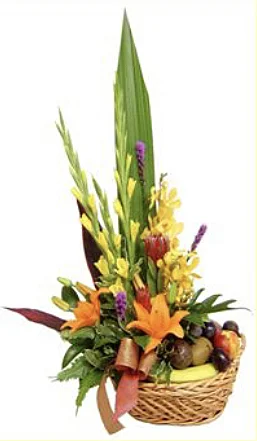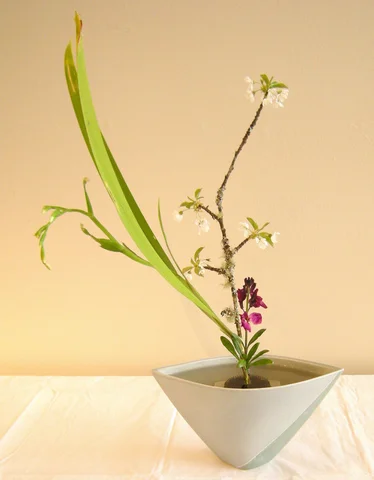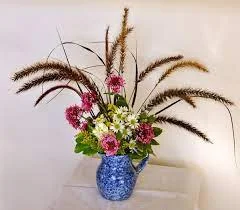-
-
 The people in this time period had orderly alternating patterns that were simplistic and did not overlap.
The people in this time period had orderly alternating patterns that were simplistic and did not overlap. -
-
 The Greeks introduced the cornucopia and the colors were not important, but the fragrance and symbolism was.
The Greeks introduced the cornucopia and the colors were not important, but the fragrance and symbolism was. -
-
 These arrangements were caused by the Buddhist teachings and used very foreign flowers.
These arrangements were caused by the Buddhist teachings and used very foreign flowers. -
-
 The Romans introduced the garlands, wreaths and crowns.
The Romans introduced the garlands, wreaths and crowns. -
-
 Continued with the Roman designs but were also composed of symmetrical tree-type compositions, while introducing the fruit garland.
Continued with the Roman designs but were also composed of symmetrical tree-type compositions, while introducing the fruit garland. -
-
There is little to no information about the Middle Ages period except it being symmetrical and used vases.
-
-
 The arrangements were very geometrical using scalene triangles mostly though. They also used a minimal number of blooms in their arrangements
The arrangements were very geometrical using scalene triangles mostly though. They also used a minimal number of blooms in their arrangements -
-
 The Renaissance had started in Italy and rebirthed many interests. It was influenced by the Greek and other time periods before it. It also introduced the Christmas wreath.
The Renaissance had started in Italy and rebirthed many interests. It was influenced by the Greek and other time periods before it. It also introduced the Christmas wreath. -
-
-
 This time period was very symmetrical and introduced the S-curve. The arrangements were very extravagant and extra.
This time period was very symmetrical and introduced the S-curve. The arrangements were very extravagant and extra. -
 This period introduced the topiary, and also had no focal point in the arrangements
This period introduced the topiary, and also had no focal point in the arrangements -
-
 Most people in this time period grew these flowers for food and medicine. If they were in arrangements, then they were very simple
Most people in this time period grew these flowers for food and medicine. If they were in arrangements, then they were very simple -
-
 There was very little to no concern for design in this period. It was named after the English Monarch King George VIII
There was very little to no concern for design in this period. It was named after the English Monarch King George VIII -
-
 These arrangements were very lengthy. It also introduced the fan shape and the triangle shaped arrangements
These arrangements were very lengthy. It also introduced the fan shape and the triangle shaped arrangements -
-
 This period was very similar to the French Baroque period, but was more formal than that period.
This period was very similar to the French Baroque period, but was more formal than that period. -
-
 This time period was named after King Louis XVI. The arrangements had very delicate and cool colors.
This time period was named after King Louis XVI. The arrangements had very delicate and cool colors. -
-
 This periods arrangements had fewer flowers, and had mixed bouquets.
This periods arrangements had fewer flowers, and had mixed bouquets. -
-
 This period arrangements were overflowing with the colors purple and white. This was intermixed with the Victorian Period, hence the name.
This period arrangements were overflowing with the colors purple and white. This was intermixed with the Victorian Period, hence the name. -
-
 The arrangements in this period were used to honor the emperor at the time.
The arrangements in this period were used to honor the emperor at the time. -
-
 The arrangements in this period were used to show wealth and power. It also had foliage and fruits. This period was named after the Queen of England at the time, Queen Victoria.
The arrangements in this period were used to show wealth and power. It also had foliage and fruits. This period was named after the Queen of England at the time, Queen Victoria. -
-
 The arrangements in this period were patterned after nature. The arrangements were also very asymmetrical.
The arrangements in this period were patterned after nature. The arrangements were also very asymmetrical. -
-
 This period introduced corsages. The arrangements were strong with geometric shapes.
This period introduced corsages. The arrangements were strong with geometric shapes. -
-
 This period was very expressive and was abstract and free.
This period was very expressive and was abstract and free. -
This time period, kind of like the Freeform Expressive Period, was very abstract but had very stiff patterns.
-
 This time period, kind of like the Freeform Expressive Period, was very abstract but had very stiff patterns.
This time period, kind of like the Freeform Expressive Period, was very abstract but had very stiff patterns. -
-
 The Modern Period is still going on today. The arrangements are minimalist and very sleek and simple.
The Modern Period is still going on today. The arrangements are minimalist and very sleek and simple.